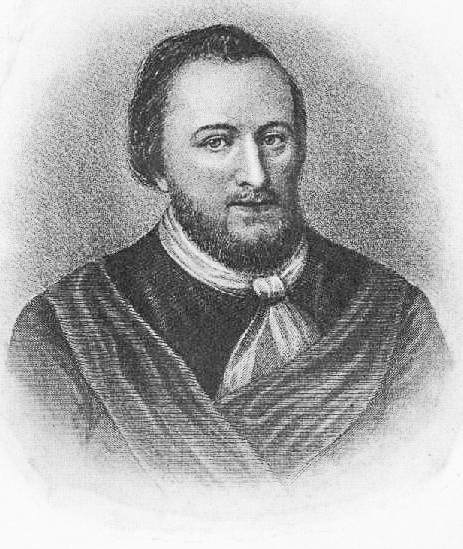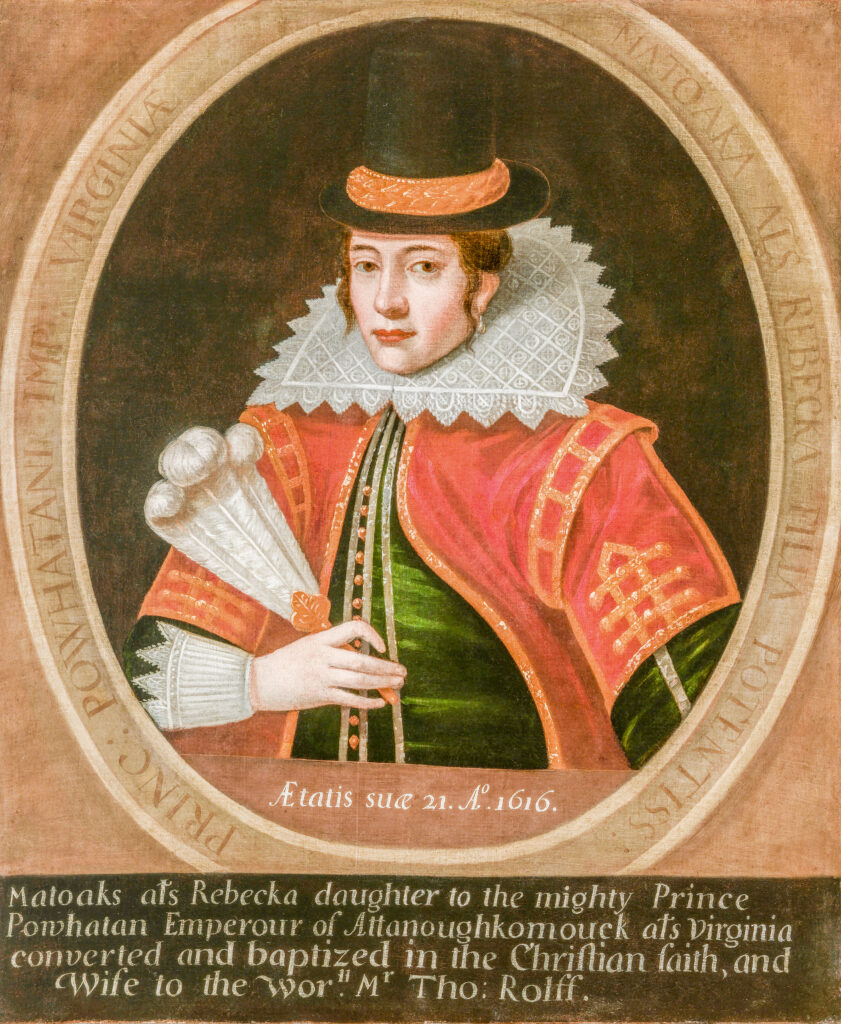History of Virginia
A bit of early History of Virginia, where our early generations of the Van Metre Family acquired Land Grants and settled. Covering the time before Virginia was Virginia and includes areas that will become current Maryland, kMassachusetts, Virginia, West Virginia and North Carolina, from 1540 through the English Colonization.
Spanish 1540-1609
Table of Contents
Another Spanish party, captained by Antonio Valazquez in the caravel Santa Catalina, explored to the lower Chesapeake Bay region of Virginia in mid- 1561 under the orders of Ángel de Villafañe. During this voyage, two Kiskiack or Paspahegh youths, including Don Luis were taken back to Spain. In 1566, an expedition sent from Spanish Florida by Pedro Menéndez de Avilés reached the Delmarva Peninsula. The expedition consisted of two Dominican friars, thirty soldiers and Don Luis, in a failed effort to set up a Spanish colony in the Chesapeake, believing it to be an opening to the fabled Northwest passage.
In 1570, Spanish Jesuits established the Ajacán Mission on the lower peninsula. However, in 1571 it was destroyed by Don Luis and a party of his indigenous allies. In August 1572, Pedro Menéndez de Avilés arrived from St. Augustine with thirty soldiers and sailors to take revenge for the massacre of the Jesuits, and hanged approximately 20 natives. In 1573, the governor of Spanish Florida, Pedro Menéndez de Márquez, concluded further exploration of the Chesapeake. In the 1580s, captain Vicente González led several voyages into the Chesapeake in search of English settlement in the area. In 1609, Spanish Florida governor Pedro de Ibarra sent Francisco Fernández de Écija from St. Augustine to survey the activities of the Jamestown colonists, yet Spain never attempted a colony after the failure of the Ajacán Mission.
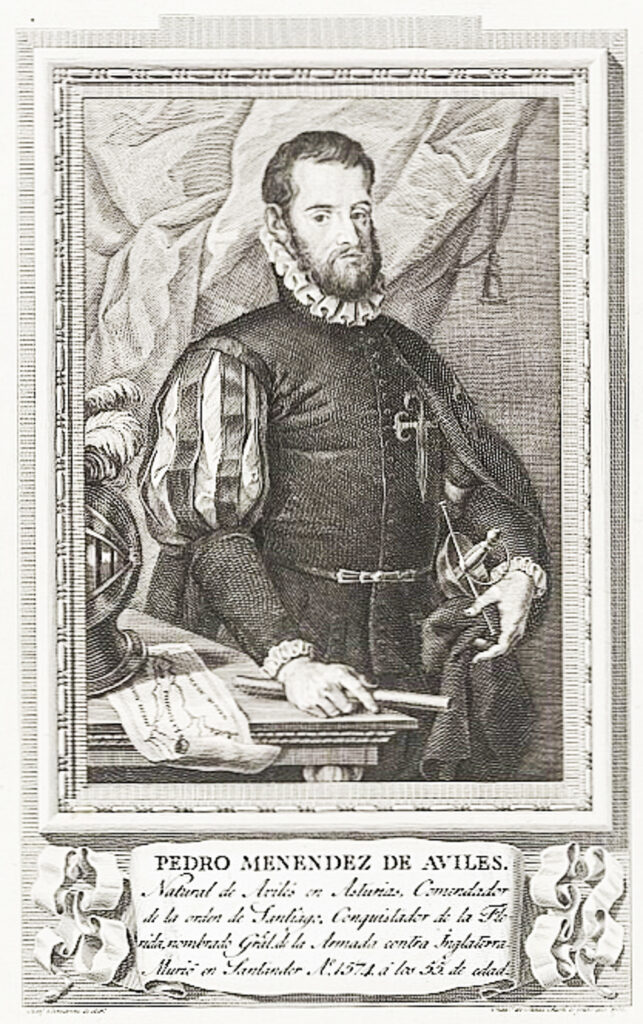
Pedro Menéndez de Avilés
(1519-1574)1
Colony of Virginia 1606-1609
The name Virginia came from information gathered by the Raleigh-sponsored English explorations along what is now the North Carolina coast. Philip Amadas and Arthur Barlowe reported that a regional “king” named Wingina ruled a land of Wingandacoa. Queen Elizabeth modified the name to “Virginia”, perhaps in part noting her status as the “Virgin Queen.” Though the word is Latinate, it stands as the oldest English language place name in the United States. This would have been about 1585.
On the second voyage, Raleigh discovered that, while the chief of the Secotans was indeed called Wingina, the expression Wingandacoa, heard by the English upon arrival actually meant “You wear good clothes” in Carolina Algongquian, and was not the native name of the country, as previously misunderstood.
Virginia Company of London
Following the failure of earlier colonization attempts, England resumed attempts to set up a number of colonies. This time joint stock companies were used rather than giving extensive grants to a landed proprietor such as Gilbert of Raleigh.
After the death of Queen Elizabeth I, in 1603 King James I assumed the throne of England. After years of war, England was strapped for funds, so he granted responsibility for England’s New World colonization to the Virginia Company (1606-1624), which became incorporated as a joint stock company by a proprietary charter drawn up in 1606.
London Company & Plymouth Company
There were two competing branches of the Virginia Company, the Plymouth Company and the London Company. Each hoped to establish a colony in Virginia in order to exploit gold (which the region did not actually have), to establish a base of support for English privateering against Spanish ships, and to spread Protestantism to the New World in competition with Spain’s spread of Catholicism.
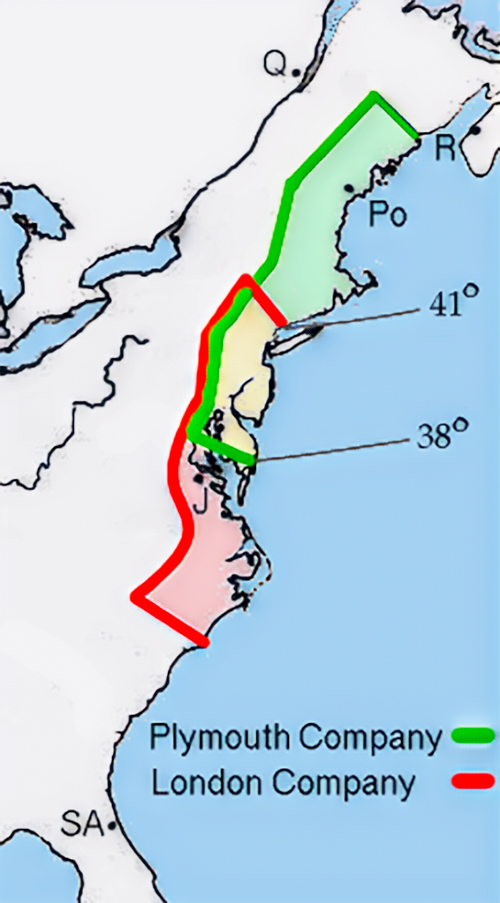
King James Grants.
Q – Quebec (France);
R – Port Royal (France);
Po – Popham Colony;
J – Jamestown (England);
SA – Saint Augustine (Spain).2
By the terms of the charter, the Plymouth Company was permitted to establish a colony of 100 miles square between the 38th parallel and the 45th parallel (roughly between Chesapeake Bay and the current U.S. –Canada border).
The London Company was permitted to establish between the 34th parallel and the 41st parallel (approximately between Cape Fear and Long Island Sound), and also owned a large portion of Atlantic and Inland Canada.
In the area of overlap, the two companies were not permitted to establish colonies within one hundred miles of each other. During 1606, each company organized expeditions to establish settlements within the area of their rights.
The London company formed Jamestown in its exclusive territory, whilst the Plymouth company formed the Popham Colony in its exclusive territory near what is now Phippsburg, Maine. Popham Colony—also known as the Sagadahoc Colony.
Popham Settlement
Popham Settlement was a short-lived English colonial settlement in North America that was founded in 1607, a few months after its more successful rival, the colony at Jamestown. The Popham Colony was the first colony in the region that would eventually become known as New England. The colony was abandoned after only one year, apparently more due to family changes in the leadership ranks than lack of success in the New World. The loss of life of the colonists in 1607 and ’08 at Popham was far lower than that experienced at Jamestown.
Jamestown Settlement
In December 1606, the London Company dispatched a group of 104 men and boys in three ships: the Susan Constant, Godspeed, and Discovery, under the command of Captain Christopher Newport. After a long, rough voyage of 144 days, the colonists finally arrived in Virginia on 26 April 1607 at the entrance to the Chesapeake Bay. At Cape Henry, they went ashore, erected a cross, and did a small amount of exploring, an event which came to be called the “First Landing.”
Under orders from London to seek a more inland location safe from Spanish raids, they explored the Hampton Roads area and sailed up the newly christened James River to the fall line at what would later become the cities of Richmond and Manchester. They named Cape Henry in honor of Henry Frederick Stuart, the elder of two sons of King James I of England to survive to the age of 18 and heir-apparent to the throne of Great Britain.
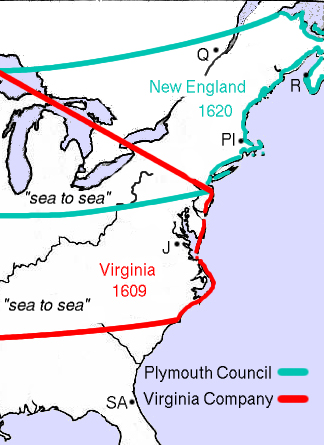
Image represents map of the eastern coast of the USA of today; the extension of the rights granted to the Virginia Company by the Plymouth Council, widely known as “from sea to sea”.3
After weeks of exploration, the colonists selected a location and founded Jamestown on 14 May 1607. It was named in honor of King James I (as was the river). However, while the location at Jamestown Island was favorable for defense against foreign ships, the low and marshy terrain was harsh and inhospitable for a settlement. It lacked drinking water, access to game for hunting, or much space for farming. While it seemed favorable that it was not inhabited by the Native Americans, within a short time, the colonists were attacked by members of the local Paspahegh tribe.
The colonists arrived ill-prepared to become self-sufficient. They had planned on trading with the Native Americans for food, were dependent upon periodic supplies from England, and had planned to spend some of their time seeking gold. Leaving the Discovery behind for their use, Captain Newport returned to England with the Susan Constant and the Godspeed, and came back twice during 1608 with the First Supply and Second Supply missions. Trading and relations with the Native Americans was tenuous at best, and many of the colonists died from disease, starvation, and conflicts with the natives. After several failed leaders, Captain John Smith took charge of the settlement, and many credit him with sustaining the colony during its first years, as he had some success in trading for food and leading the discouraged colonists.
After Smith’s return to England in August 1609, there was a long delay in the scheduled arrival of supplies. During the winter of 1609/10, along with other survivors of the wreck of the Sea Venture that resulted in Bermuda being added to the territory of Virginia, he discovered over 80% of the 500 colonists had died; many of the survivors were sick.
In 1609, with the abandonment of the Plymouth Company settlement, the London Company’s Virginia charter was adjusted to include the territory north of the 34th parallel and south of the 39th parallel, with its original coastal grant extended “from sea to sea”. Thus, according to James I’s writ, the Virginia Colony in its original sense extended to the coast of the Pacific Ocean, in what is now California, with all the states in between (Kentucky, Missouri, Colorado, Utah, etc.) belonging to Virginia. For practical purposes, though, the colonists rarely venture far inland to what was known as “The Virginia Wilderness”, although the concept itself helped renew the interest of investors, and additional funds enabled.
Below is a map of the Colony of Virginia showing the area of the 1609 Charter. The Charter of Carolina was established 1663/1665. North and South Carolina split in 1712, boundary uncertain until 1771. Georgia was part of Carolina until 1732.
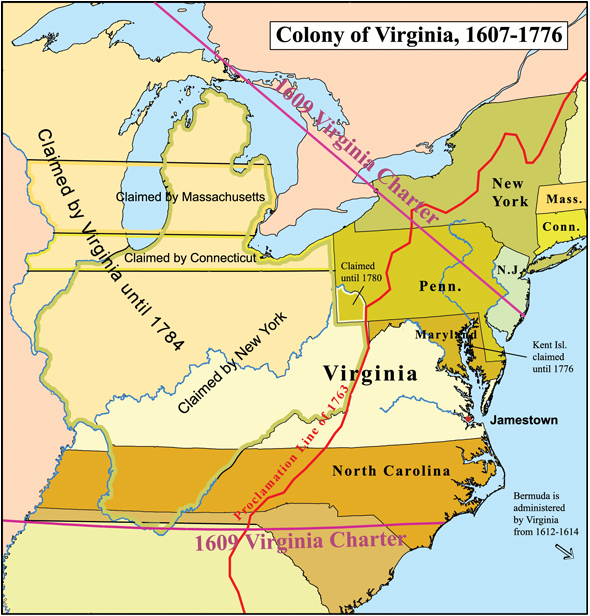
Colony of Virginia, 1607-17764
Governor Thomas West and Pocahontas
On May 23, 1609, the Virginia Company was reorganized under its Second Charter, which gave most leadership authority of the colony to the governor, the newly appointed Thomas West, 3rd Baron de La Warr. [for whom the bay, the river, a Native American people and U.S. state, all called Delaware, were named]. In June 1610, he arrived with 1550 men and ample supplies. De La Warr began the First Anglo-Powhatan War, against the natives.
De La Warr returned to England due to illness in the spring of 1611, leaving his deputy, Sir Thomas Dale, in charge of the colony. Now serving under Dale, Samuel Argall, who was looking for food for the settlement, sailed up the Potomac River. There, he traded with the Patawomecks, a Native American tribe. When two English colonists began trading with the Patawomecks, they discovered the presence of Pocahontas, the daughter of Wahunsonacock, Chief of the Powhatan Confederacy. As soon as he heard this, Argall resolved to capture Pocahontas.
Sending for the local chief, Japazaws, Argall told him he must bring her on board his ship, and suggested luring her with the present of a copper kettle. With the help of Japazaws, they tricked Pocahontas into captivity and held her for a time at Jamestown, then later at Henricus (now Henricus National Park near Dutch Gap, Virginia). Their purpose was to ransom her for some English prisoners held by Chief Powhatan, along with various weapons and farming tools that the Powhatans had stolen. Powhatan returned the prisoners but failed to satisfy the colonists with the number of weapons and tools he returned, and a long standoff ensued. The First Anglo-Powhatan War ended when Rolfe married Pocahontas in 1614.
Samuel Argall also commanded the ship that took Pocahontas (now Rebecca Rolfe), her half-sister Matachanna, and Matachanna’s husband, Uttamatomakkin, to England in 1616, as well as the ship that was in the Thames Estuary about to carry Pocahontas home to Virginia when she died suddenly.
After receiving complaints from the Virginia settlers about Argall’s tyranny on his behalf, Lord De La Warr set sail for Virginia again in 1618 to investigate those charges. He died at sea en route to Virginia and it is believed his body was brought to Jamestown for burial.
Plantation Beginnings
The economy of the Colony was another problem. Gold had never been found, and efforts to introduce profitable industries in the colony had all failed until John Rolfe introduced his two foreign types of tobacco: Orinoco and Sweet Scented. These produced a better crop than the local variety and with the first shipment to England in 1612, the customers enjoyed the flavor, thus making tobacco a cash crop that established Virginia’s economic viability.
In November 1618, Sir George Yeardley was appointed to serve three years as governor of Virginia only a month after he married Temperance Flowerdew. She had sailed for Virginia in the 1609 expedition, aboard the Faulcon, arriving at Jamestown in August 1609, and was one of the few survivors of the Starving Time.
Yeardley was a planter and three-time colonial Governor of the Colony of Virginia. A survivor of the Virginia Company of London’s ill-fated Third Supply Mission, whose flagship, the Sea Venture, was shipwrecked on Bermuda for 10 months in 1609-10. After eight weeks at sea, and seven days from expected landfall, the convoy ran into a tropical storm and the Sea Venture was shipwrecked in the Bermudas. Fortunately, everyone survived the storm. Despite numerous problems, including civil unrest among the former passengers resulting in Gates to declare martial law, two small ships were built within 10 months. The two ships the 70-80-ton Deliverance and the 30-ton pinnace Patience, arrived at Jamestown on May 23, 1610.
Yeardley is best remembered for presiding over the initial session of the first representative legislative body in Virginia in 1619. With representatives from throughout the settled portion of the colony, the group became known as the House of Burgesses. It has met continuously since, and is known in modern times as the Virginia General Assembly.
One of his first accomplishments was to come to an agreement with the Chickahominy Indians that secured food and peace for two years.
Also in 1619, the Virginia Company sent 90 single women as potential wives for the male colonists to help populate the settlement. That same year the colony acquired a group of “twenty and odd” Angolans, brought by two English privateers. They were probably the first Africans in the colony. They, along with many European indentured servants helped to expand the growing tobacco industry which was already the colony’s primary product. Although these black men were treated as indentured servants, this marked the beginning of America’s history of slavery. Major importation of enslaved Africans by European slave traders did not take place until much later in the century.
In some areas, individual rather than communal land ownership or leaseholds were established, providing families with motivation to increase production, improve standards of living, and gain wealth.
The economy of the Colony was another problem. Gold had never been found, and efforts to introduce profitable industries in the colony had all failed until John Rolfe introduced his two foreign types of tobacco: Orinoco and Sweet Scented. These produced a better crop than the local variety and with the first shipment to England in 1612, the customers enjoyed the flavor, thus making tobacco a cash crop that established Virginia’s economic viability.
In November 1618, Sir George Yeardley was appointed to serve three years as governor of Virginia only a month after he married Temperance Flowerdew. She had sailed for Virginia in the 1609 expedition, aboard the Faulcon, arriving at Jamestown in August 1609, and was one of the few survivors of the Starving Time.
Yeardley was a planter and three-time colonial Governor of the Colony of Virginia. A survivor of the Virginia Company of London’s ill-fated Third Supply Mission, whose flagship, the Sea Venture, was shipwrecked on Bermuda for 10 months in 1609-10. After eight weeks at sea, and seven days from expected landfall, the convoy ran into a tropical storm and the Sea Venture was shipwrecked in the Bermudas. Fortunately, everyone survived the storm. Despite numerous problems, including civil unrest among the former passengers resulting in Gates to declare martial law, two small ships were built within 10 months. The two ships the 70-80-ton Deliverance and the 30-ton pinnace Patience, arrived at Jamestown on May 23, 1610.
Yeardley is best remembered for presiding over the initial session of the first representative legislative body in Virginia in 1619. With representatives from throughout the settled portion of the colony, the group became known as the House of Burgesses. It has met continuously since, and is known in modern times as the Virginia General Assembly.
One of his first accomplishments was to come to an agreement with the Chickahominy Indians that secured food and peace for two years.
Also in 1619, the Virginia Company sent 90 single women as potential wives for the male colonists to help populate the settlement. That same year the colony acquired a group of “twenty and odd” Angolans, brought by two English privateers. They were probably the first Africans in the colony. They, along with many European indentured servants helped to expand the growing tobacco industry which was already the colony’s primary product. Although these black men were treated as indentured servants, this marked the beginning of America’s history of slavery. Major importation of enslaved Africans by European slave traders did not take place until much later in the century.
In some areas, individual rather than communal land ownership or leaseholds were established, providing families with motivation to increase production, improve standards of living, and gain wealth.
Virginians were intensely individualistic at this point, weakening the small new communities. Farms were scattered and few villages or towns were formed. This led to the failure of settlers to provide defense for themselves against the Indians, resulting in two massacres.
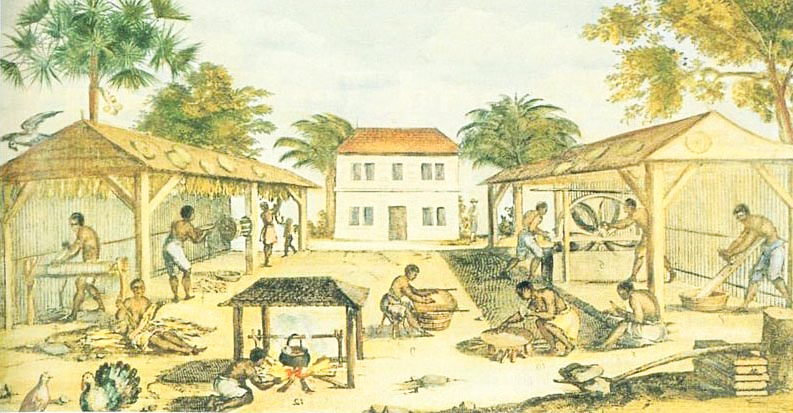
Virginia Tobacco Slaves, 16707
Conflicts with the Natives
Despite some successful interaction, issues of ownership and control of land and other resources, and trust between the peoples, became areas of conflict. Virginia has drought conditions an average of every three years. The colonists did not understand that the natives were ill-prepared to feed them during hard times. In the years after 1612, the colonists cleared land to farm export tobacco, their crucial cash crop. As tobacco exhausted the soil, the settlers continually needed to clear more land for replacement. This reduced the wooded land which Native Americans depended on for hunting to supplement their food crops. As more colonists arrived, they wanted more land.
The tribes tried to fight the encroachment by the colonists. Major conflicts took place in the Indian massacre of 1622 and the Second Anglo-Powhatan war, both under the leadership of the late Chief Powhatan’s younger brother, Chief Opechancanough. By the mid-17th century, the Powhatan and allied tribes were in serious decline in population, due in large part to epidemics of newly introduced infectious diseases, such as smallpox and measles, to which they had no natural immunity. The European colonists had expanded territory so that they controlled virtually all the land east of the fall line on the Janes River. Fifty years earlier, this territory had been the empire of the mighty Powhatan Confederacy.
By the Treaty of 1646, the colonists had taken the balance of power, and had established control between the York and Blackwater Rivers.
Crown Colony
In 1620, a successor to the Plymouth Company sent colonists to the New World aboard the Mayflower. Known as Pilgrims, they successfully established a settlement in what became Massachusetts. The portion of what had been Virginia north of the 40th parallel became known as New England, according to books written by Captain John Smith, who had made a voyage there.
In 1624, the Virginia Company’s charter was revoked and the colony transferred to royal authority as a crown colony, the elected representatives in Jamestown continued to exercise a fair amount of power. Under royal authority, the colony began to expand to the North and West with additional settlements.
In 1634, a new system of local government was created in the Virginia colony by order of the King of England. Eight shires were designated, each with its own local officers; these shires were renamed as counties a few years later and included:
- Accomac Shire (now Northampton & Accomack Counties)
- Charles City Shire (now Charles City County)
- Charles River Shire (now York County)
- Elizabeth City Shire (extinct – consolidated with the City of Hampton) • Henrico Shire (now Henrico County)
- James City Shire (now James City County)
- Warwick River Shire (extinct –consolidated with the City of Newport News)
- Warrosquyoake Shire (now Isle of Wight County)
Governor Berkeley and English Civil War
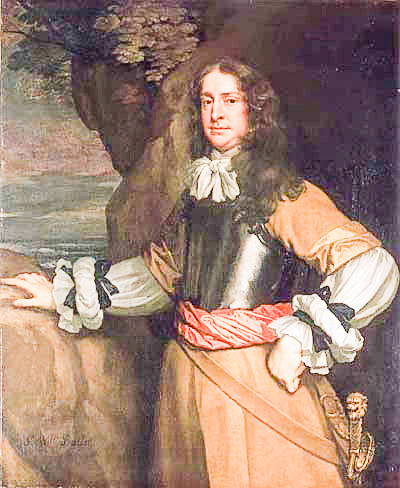
Sir William Berkeley, Governor of Virginia from 1642-1652 and 1660-1677.8
Most Virginia colonists were loyal to the crown (Charles I) during the English Civil War, but in 1652, Oliver Cromwell sent a force to remove and replace Governor Berkeley with Governor Richard Bennett, who was loyal to the Commonwealth of England. This governor was a moderate Puritan who allowed the local legislature to exercise most controlling authority, and spent much of his time directing affairs in neighboring Maryland Colony. Bennett was followed by two more “Cromwellian” governors, Edward Digges and Samuel Matthews, although in fact all three of these men were not technically appointees, but were selected by the House of Burgesses, which was really in control of the colony during these years.
Many royalists fled to Virginia after their defeat in the English Civil War. Some intermarried with existing plantation families to establish influential families in Virginia such as the Washington’s, Randolph’s, Carters and Lees. However, most 17th century immigrants were indentured servants, merchants or artisans. After the Restoration, in recognition of Virginia’s loyalty to the crown, Kings Charles II of England bestowed Virginia with the nickname “The Old Dominion”, which it still bears today.
Governor Alexander Spotswood
In 1710, Alexander Spotswood was appointed Lieutenant Governor of Virginia, under the nominal governorship of George Hamilton, 1st Earl of Orkney. He was the first to occupy the new Governor’s Mansion in Williamsburg.
In 1714, he founded the First Germanna Colony, in modern day Orange County, and regulated trade with Native Americans at Fort Christanna, one of his pet projects. The establishment of German immigrants on the Germanna tract in 1714, was partly for frontier defense but mainly to operate his newly developed ironworks. In 1715, he bought 3229 acres at Germanna.
In 1716, he led the Knights of the Golden Horseshoe Expedition, reaching the top ridge of the Blue Ridge Mountains at Swift Run Gap.
Germanna was the seat of Spotsylvania County from 1720 to 1732. Spotswood erected a palatial home and after the Germans moved away, continued the ironworks with slave labor. In his later years, he served as Deputy Postmaster General for the Colonies. The site of the first settlement is located in present-day Orange County along the banks of the Rapidan River.
In 1720 the Privy Council granted Spotswood 86,000 acres in the newly created Spotsylvania County, of which the Germanna Tracts was the first, while he was Lieutenant Governor and actual executive head of the Virginia government.
Spotswood completed the Governor’s palace in 1722, when he was recalled from the lieutenant governorship and replaced by Hugh Drysdale
Hugh Drysdale served as Lieutenant Governor of colonial Virginia from September 1722 until his death in July 1726. Because of the relative peace and calm that marked his time as governor, comparatively little is known about him today.
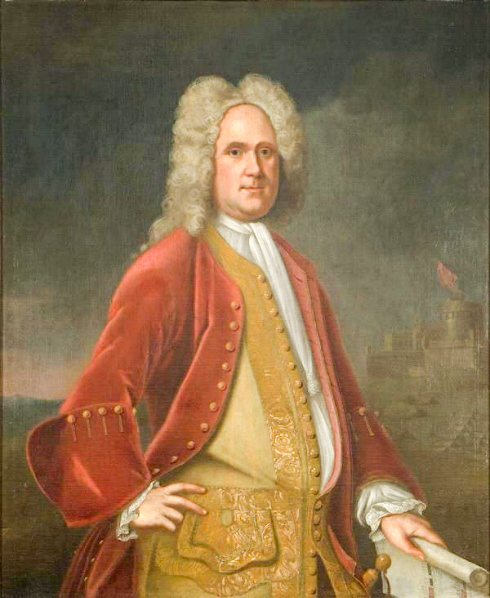
Alexander Spotswood9
Governor Sir William Gooch
Sir William Gooch, 1st Baronet (1681-1751), served as Governor of Virginia from 1727 through 1749. One of his greatest successes was the passage of the Tobacco Inspection Act of 1730. The Act called for the inspection and regulation of Virginia’s tobacco, the most important crop of the colony. Tobacco planters were required to transport their crop to public warehouses where it was inspected and stored. The Act raised the quality of Virginia’s tobacco and reduced fraud; this greatly increased the demand for Virginia tobacco in Europe.
By the 1730’s, the Three Notch’d Road extended from the vicinity of the fall line of the James River at the future site of Richmond westerly to the Shenandoah
Valley, crossing the Blue Ridge Mountains at Jarmans Gap. Around this time governor William Gooch promoted settlement of the Virginia backcountry as a means to insulate the Virginia colony from Native American and New France settlement in the Ohio Country. In response, a wide variety of settlers traveled southward on the Indian Trail later known as the Great Wagon Road along the Shenandoah Valley from Pennsylvania. By 1735 there were as many as 160 families in the backcountry region, and within ten years nearly 10,000 Europeans lived in the Shenandoah Valley.
Governor Gooch is who our John and Isaac Van Matre received their 40,000 acre Virginia land grants from.
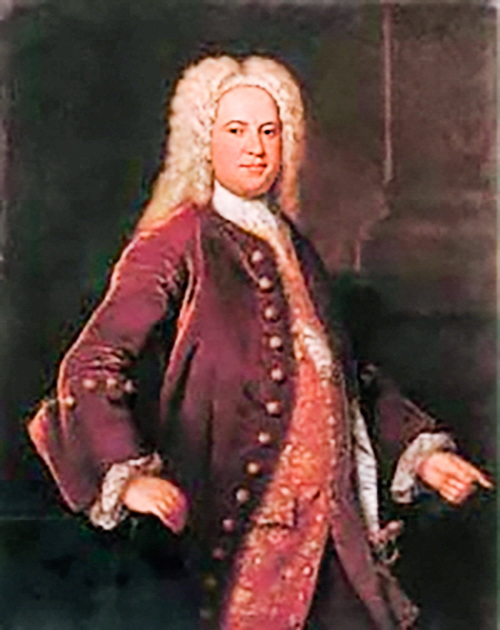
Sir William Gooch10
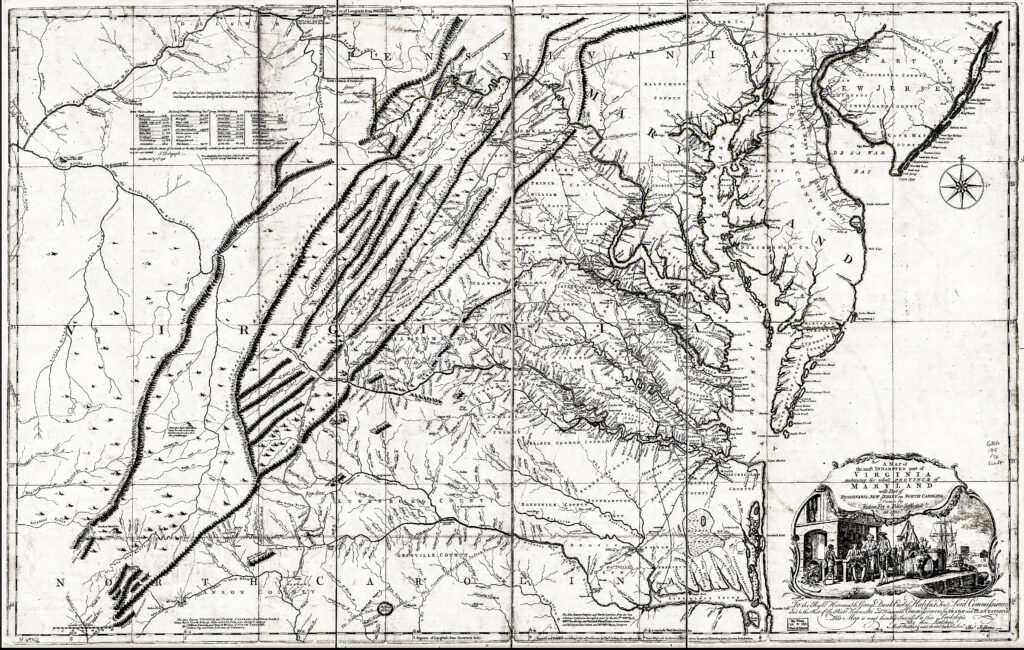
A map of the most inhabited part of Virginia containing the whole province of Maryland with part of Pennsylvania, New Jersey and North Carolina. Drawn by Joshua Fry & Peter Jefferson in 1751, published by Thos. Jefferys, London, 1755. This landmark map, unusual in that it relied on firsthand surveys, is the first correct depiction of the Allegheny Mountains, complete with “The Great Road from the Yadkin River through Virginia to kPhiladelphia distant 455 Miles” – an accurate survey of what would come to be styled th Great Philadelphia Wagon Road.11
Virginia is one of the 13 original colonies and was the first part of the country permanently settled by the English, who established Jamestown on the banks of the James River in 1607. The home state of George Washington, Thomas Jefferson and other founding fathers, Virginia played an important role in the American Revolution (1775-83). During the Civil War (1861-65), the city of Richmond, Virginia, became the capital of the Confederacy, and more than half of the conflict’s battles were fought in the state. Today, many government institutions are headquartered in Virginia, particularly in Arlington, located across the Potomac River from Washington, D.C.
Citations and Attributes:
- Pedro Menéndez de Avilés 1519-1574. By Francisco de Paula Martí - This image is available from the United States Library of Congress's Prints and Photographs division under the digi- tal ID ppmsca.09317.This tag does not indicate the copyright status of the attached work. A normal copyright tag is still required. See Commons:Licensing for more information. Public Domain, https://commons.wikimedia.org/w/index.php?curid=4041051
- King James Grants. Q - Quebec (France); R - Port Royal (France); Po - Popham Colony (En- gland); J - Jamestown (England) ; SA - Saint Augustine (Spain). CC BY-SA 3.0, https://com- mons.wikimedia.org/w/index.php?curid=685738. This file is licensed under the Creative Com- mons Attribution-Share Alike 3.0 Unported license. Subject to disclaimers.
- Image represents map of the eastern coast of the USA of today; the extension of the rights granted to the Virginia Company by the Plymouth Council, widely known as "from sea to sea". By en:User:Decumanus - Wikipedia in the English language, see it here, CC BY-SA 3.0, https://commons.wikimedia.org/w/index.php?curid=5798321. This file is licensed under the Creative Commons Attribution-Share Alike 3.0 Unported license. Subject to disclaimers.
- Colony of Virginia 1607-1776. CC BY-SA 2.5, https://commons.wikimedia.org/w/index.php?cu- rid=1374989.
- Thomas West, 3rd Baron De La Warr (Delaware. By Contemporary portrait - http://www.tu- dorplace.com.ar/images/West,Thomas(3BDeLaWarr)03.jpg, Public Domain, https://commons. wikimedia.org/w/index.php?curid=4422670.)
- Pocahontas. By Unidentified Artist. Details of artist on Google Art Project - bgEKDMOhgPmBBA at Google Cultural Institute maximum zoom level, Public Domain, https://commons.wikimedia. org/w/index.php?curid=21870629.
- Virginia Tobacco Slaves, 1670. By Unknown - http://www.learnnc.org/lp/multimedia/8850, Public Domain, https://commons.wikimedia.org/w/index.php?curid=10648604
- Sir William Berkeley. Unknown painter. Public domain. Sir William Berkeley, governor of Vir- ginia from 1642-1652 and 1660-1677. https://www.shmoop.com/colonial-virginia/photo-wil- liam-berkeley.html.
- Portrait of Alexander Spotswood. By Charles Bridges - http://www.encyclopediavirginia.org/ media_player?mets_filename=evm00002441mets.xml, Public Domain, https://commons.wiki- media.org/w/index.php?curid=10049959.
- Sir William Gooch. By Unknown - https://www.pinterest.se/pin/225039312603056136/, Public Domain, https://commons.wikimedia.org/w/index.php?curid=58362394.
- A map of the most inhabited part of Virginia containing the whole province of Maryland with part of Pennsylvania, New Jersey and North Carolina. Drawn by Joshua Fry & Peter Jefferson in 1751, published by Thos. Jefferys, London, 1755. This landmark map, unusual in that it relied on firsthand surveys, is the first correct depiction of the Allegheny Mountains, complete with 'The Great Road from the Yadkin River through Virginia to Philadelphia distant 455 Miles' - an accurate survey of what would come to be styled the Great Philadelphia Wagon Road. By http://hdl.loc.gov/loc.gmd/g3880.ct000370, Public Domain, https://commons.wikimedia. org/w/index.php?curid=21734972.

